Yup'ik vs Paraguayan Community Comparison
COMPARE
Yup'ik
Paraguayan
Social Comparison
Social Comparison
Yup'ik
Paraguayans
2,388
SOCIAL INDEX
21.4/ 100
SOCIAL RATING
262nd/ 347
SOCIAL RANK
7,568
SOCIAL INDEX
73.2/ 100
SOCIAL RATING
112th/ 347
SOCIAL RANK
Paraguayan Integration in Yup'ik Communities
The statistical analysis conducted on geographies consisting of 23,740,818 people shows a substantial positive correlation between the proportion of Paraguayans within Yup'ik communities in the United States with a correlation coefficient (R) of 0.596. On average, for every 1% (one percent) increase in Yup'ik within a typical geography, there is an increase of 0.032% in Paraguayans. To illustrate, in a geography comprising of 100,000 individuals, a rise of 1,000 Yup'ik corresponds to an increase of 31.7 Paraguayans.
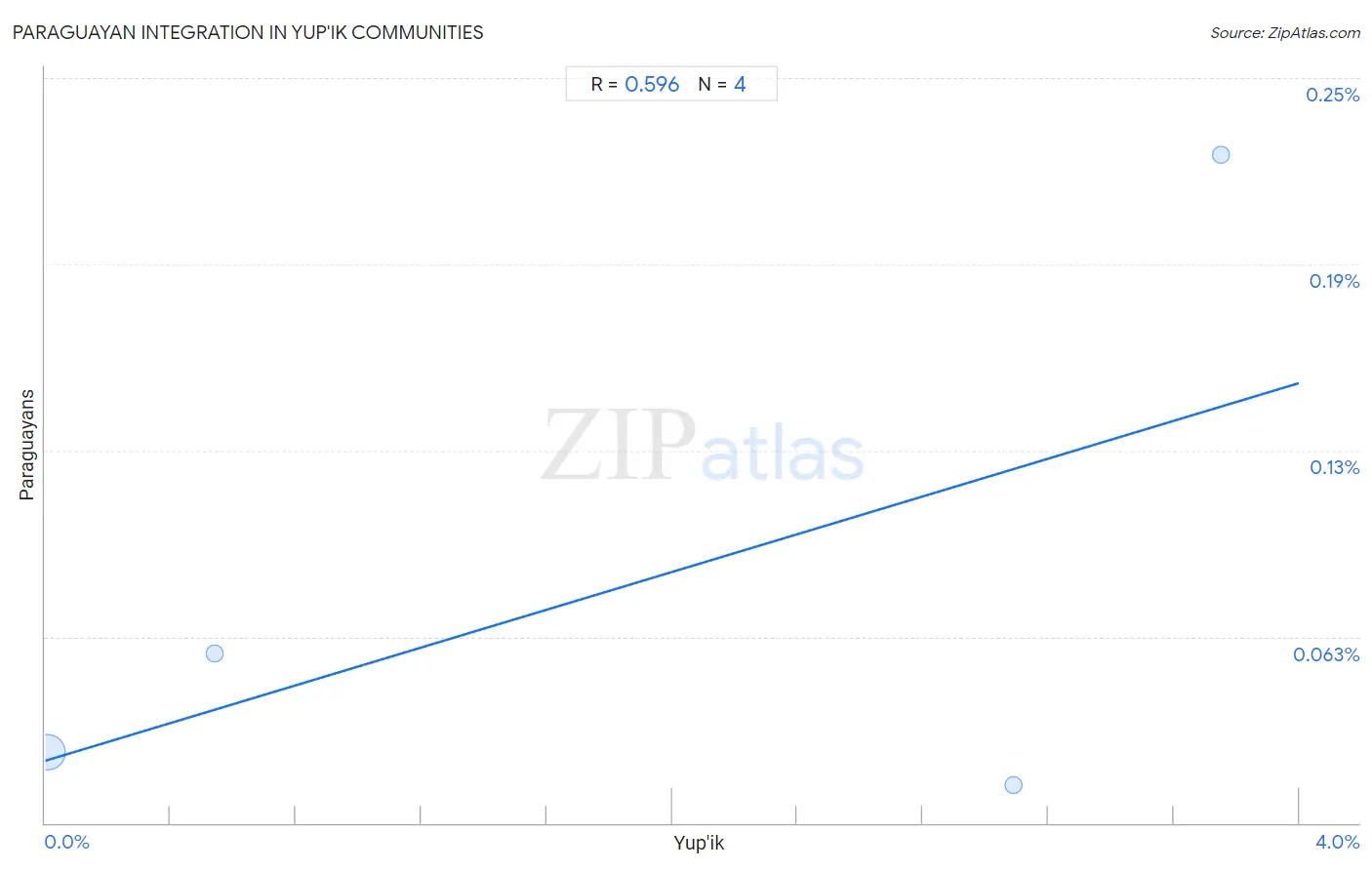
Yup'ik vs Paraguayan Income
When considering income, the most significant differences between Yup'ik and Paraguayan communities in the United States are seen in per capita income ($30,518 compared to $50,385, a difference of 65.1%), median male earnings ($39,504 compared to $59,975, a difference of 51.8%), and householder income ages 25 - 44 years ($73,688 compared to $106,615, a difference of 44.7%). Conversely, both communities are more comparable in terms of householder income under 25 years ($54,732 compared to $55,614, a difference of 1.6%), wage/income gap (24.7% compared to 25.8%, a difference of 4.7%), and householder income over 65 years ($60,727 compared to $64,443, a difference of 6.1%).

| Income Metric | Yup'ik | Paraguayan |
| Per Capita Income | Tragic $30,518 | Exceptional $50,385 |
| Median Family Income | Tragic $79,290 | Exceptional $114,016 |
| Median Household Income | Tragic $69,695 | Exceptional $95,737 |
| Median Earnings | Tragic $35,942 | Exceptional $51,068 |
| Median Male Earnings | Tragic $39,504 | Exceptional $59,975 |
| Median Female Earnings | Tragic $32,730 | Exceptional $43,173 |
| Householder Age | Under 25 years | Exceptional $54,732 | Exceptional $55,614 |
| Householder Age | 25 - 44 years | Tragic $73,688 | Exceptional $106,615 |
| Householder Age | 45 - 64 years | Tragic $81,000 | Exceptional $109,447 |
| Householder Age | Over 65 years | Average $60,727 | Exceptional $64,443 |
| Wage/Income Gap | Exceptional 24.7% | Average 25.8% |
Yup'ik vs Paraguayan Poverty
When considering poverty, the most significant differences between Yup'ik and Paraguayan communities in the United States are seen in receiving food stamps (32.7% compared to 10.7%, a difference of 206.1%), single male poverty (31.6% compared to 11.6%, a difference of 172.2%), and married-couple family poverty (13.4% compared to 5.1%, a difference of 160.1%). Conversely, both communities are more comparable in terms of single mother poverty (32.5% compared to 27.2%, a difference of 19.3%), seniors poverty over the age of 65 (14.1% compared to 11.4%, a difference of 22.9%), and seniors poverty over the age of 75 (15.8% compared to 12.7%, a difference of 24.7%).
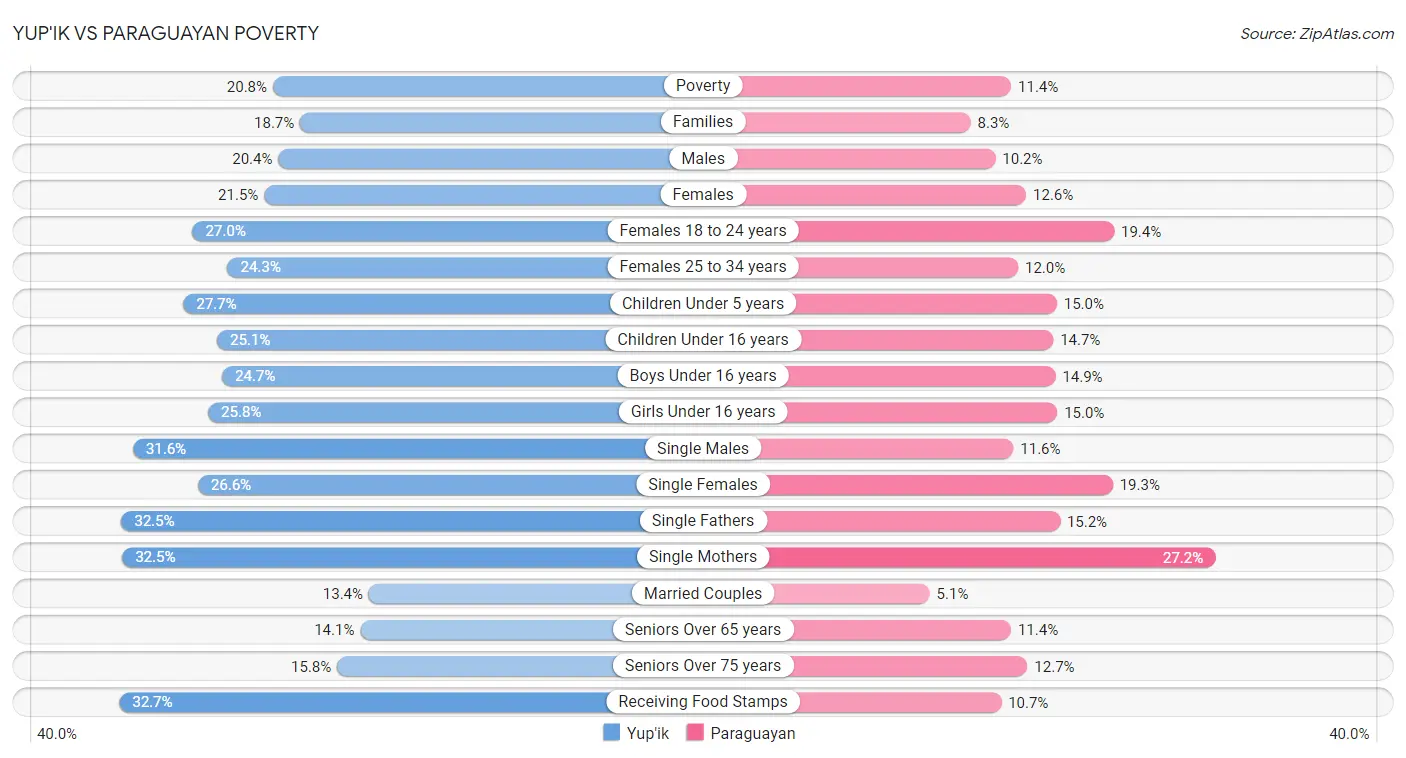
| Poverty Metric | Yup'ik | Paraguayan |
| Poverty | Tragic 20.8% | Exceptional 11.4% |
| Families | Tragic 18.7% | Exceptional 8.3% |
| Males | Tragic 20.4% | Exceptional 10.2% |
| Females | Tragic 21.5% | Exceptional 12.6% |
| Females 18 to 24 years | Tragic 27.0% | Exceptional 19.4% |
| Females 25 to 34 years | Tragic 24.3% | Exceptional 12.0% |
| Children Under 5 years | Tragic 27.7% | Exceptional 15.0% |
| Children Under 16 years | Tragic 25.1% | Exceptional 14.7% |
| Boys Under 16 years | Tragic 24.7% | Exceptional 14.9% |
| Girls Under 16 years | Tragic 25.8% | Exceptional 15.0% |
| Single Males | Tragic 31.6% | Exceptional 11.6% |
| Single Females | Tragic 26.6% | Exceptional 19.3% |
| Single Fathers | Tragic 32.5% | Exceptional 15.2% |
| Single Mothers | Tragic 32.5% | Exceptional 27.2% |
| Married Couples | Tragic 13.4% | Good 5.1% |
| Seniors Over 65 years | Tragic 14.1% | Poor 11.4% |
| Seniors Over 75 years | Tragic 15.8% | Poor 12.7% |
| Receiving Food Stamps | Tragic 32.7% | Exceptional 10.7% |
Yup'ik vs Paraguayan Unemployment
When considering unemployment, the most significant differences between Yup'ik and Paraguayan communities in the United States are seen in unemployment among ages 30 to 34 years (18.5% compared to 5.1%, a difference of 258.7%), unemployment among ages 35 to 44 years (14.4% compared to 4.2%, a difference of 240.9%), and male unemployment (16.4% compared to 4.9%, a difference of 236.1%). Conversely, both communities are more comparable in terms of unemployment among seniors over 75 years (12.8% compared to 8.7%, a difference of 46.9%), unemployment among ages 65 to 74 years (9.5% compared to 5.6%, a difference of 69.7%), and unemployment among seniors over 65 years (9.1% compared to 5.4%, a difference of 70.3%).
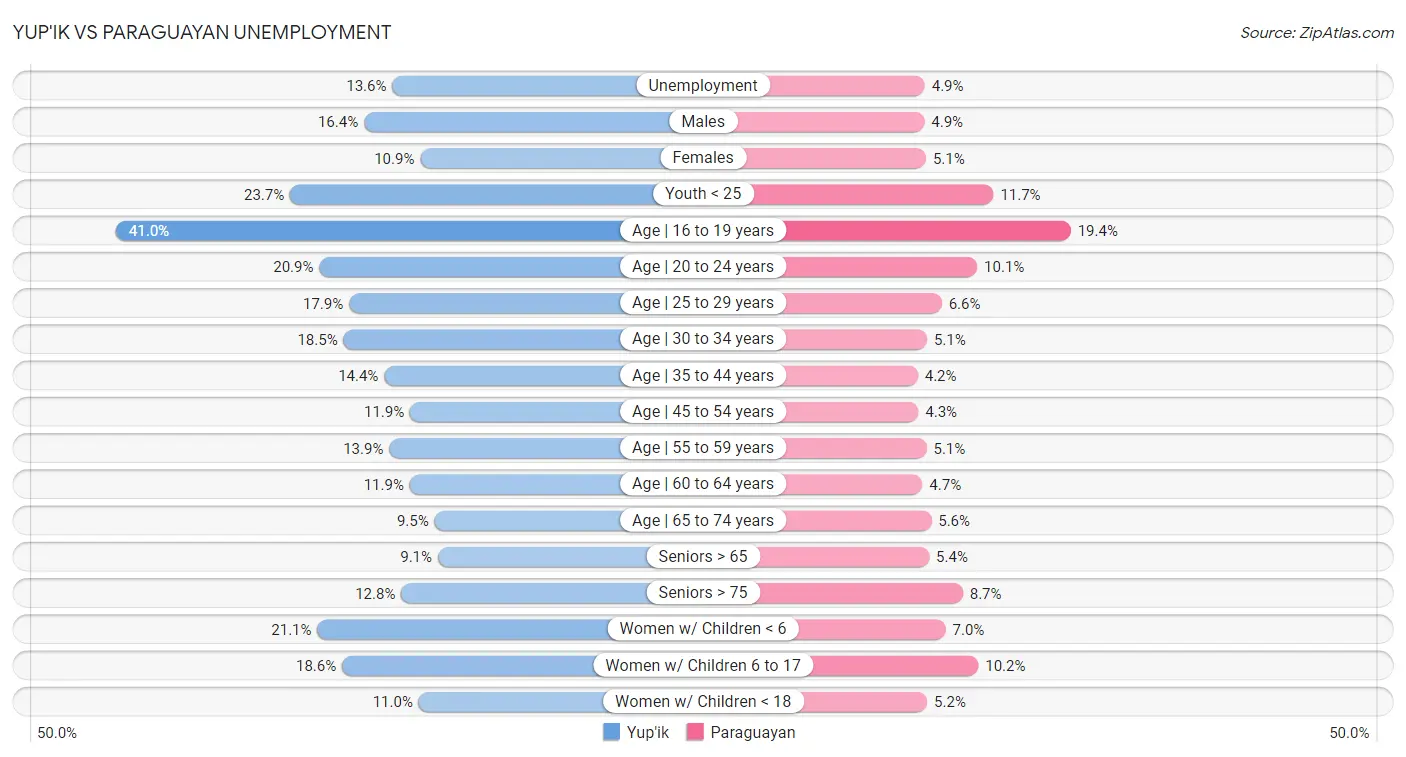
| Unemployment Metric | Yup'ik | Paraguayan |
| Unemployment | Tragic 13.6% | Exceptional 4.9% |
| Males | Tragic 16.4% | Exceptional 4.9% |
| Females | Tragic 10.9% | Exceptional 5.1% |
| Youth < 25 | Tragic 23.7% | Fair 11.7% |
| Age | 16 to 19 years | Tragic 41.0% | Tragic 19.4% |
| Age | 20 to 24 years | Tragic 20.9% | Excellent 10.1% |
| Age | 25 to 29 years | Tragic 17.9% | Good 6.6% |
| Age | 30 to 34 years | Tragic 18.5% | Exceptional 5.1% |
| Age | 35 to 44 years | Tragic 14.4% | Exceptional 4.2% |
| Age | 45 to 54 years | Tragic 11.9% | Exceptional 4.3% |
| Age | 55 to 59 years | Tragic 13.9% | Tragic 5.1% |
| Age | 60 to 64 years | Tragic 11.9% | Exceptional 4.7% |
| Age | 65 to 74 years | Tragic 9.5% | Tragic 5.6% |
| Seniors > 65 | Tragic 9.1% | Tragic 5.4% |
| Seniors > 75 | Tragic 12.8% | Good 8.7% |
| Women w/ Children < 6 | Tragic 21.1% | Exceptional 7.0% |
| Women w/ Children 6 to 17 | Tragic 18.6% | Tragic 10.2% |
| Women w/ Children < 18 | Tragic 11.0% | Exceptional 5.2% |
Yup'ik vs Paraguayan Labor Participation
When considering labor participation, the most significant differences between Yup'ik and Paraguayan communities in the United States are seen in in labor force | age 25-29 (73.1% compared to 85.9%, a difference of 17.6%), in labor force | age 30-34 (76.4% compared to 85.8%, a difference of 12.3%), and in labor force | age 35-44 (77.3% compared to 85.4%, a difference of 10.5%). Conversely, both communities are more comparable in terms of in labor force | age 16-19 (33.3% compared to 33.8%, a difference of 1.7%), in labor force | age 20-24 (70.9% compared to 73.7%, a difference of 4.0%), and in labor force | age > 16 (62.7% compared to 66.5%, a difference of 6.1%).

| Labor Participation Metric | Yup'ik | Paraguayan |
| In Labor Force | Age > 16 | Tragic 62.7% | Exceptional 66.5% |
| In Labor Force | Age 20-64 | Tragic 73.2% | Exceptional 80.6% |
| In Labor Force | Age 16-19 | Tragic 33.3% | Tragic 33.8% |
| In Labor Force | Age 20-24 | Tragic 70.9% | Tragic 73.7% |
| In Labor Force | Age 25-29 | Tragic 73.1% | Exceptional 85.9% |
| In Labor Force | Age 30-34 | Tragic 76.4% | Exceptional 85.8% |
| In Labor Force | Age 35-44 | Tragic 77.3% | Exceptional 85.4% |
| In Labor Force | Age 45-54 | Tragic 78.6% | Exceptional 83.5% |
Yup'ik vs Paraguayan Family Structure
When considering family structure, the most significant differences between Yup'ik and Paraguayan communities in the United States are seen in single father households (5.4% compared to 2.1%, a difference of 162.3%), births to unmarried women (56.4% compared to 29.7%, a difference of 90.2%), and single mother households (10.0% compared to 5.8%, a difference of 73.3%). Conversely, both communities are more comparable in terms of married-couple households (44.1% compared to 47.0%, a difference of 6.7%), divorced or separated (10.3% compared to 11.5%, a difference of 11.5%), and family households (72.4% compared to 64.1%, a difference of 13.0%).

| Family Structure Metric | Yup'ik | Paraguayan |
| Family Households | Exceptional 72.4% | Fair 64.1% |
| Family Households with Children | Exceptional 37.0% | Tragic 27.1% |
| Married-couple Households | Tragic 44.1% | Good 47.0% |
| Average Family Size | Exceptional 4.00 | Poor 3.20 |
| Single Father Households | Tragic 5.4% | Exceptional 2.1% |
| Single Mother Households | Tragic 10.0% | Exceptional 5.8% |
| Currently Married | Tragic 39.9% | Good 47.2% |
| Divorced or Separated | Exceptional 10.3% | Exceptional 11.5% |
| Births to Unmarried Women | Tragic 56.4% | Exceptional 29.7% |
Yup'ik vs Paraguayan Vehicle Availability
When considering vehicle availability, the most significant differences between Yup'ik and Paraguayan communities in the United States are seen in no vehicles in household (45.9% compared to 14.4%, a difference of 219.7%), 1 or more vehicles in household (58.4% compared to 85.7%, a difference of 46.7%), and 2 or more vehicles in household (34.9% compared to 50.3%, a difference of 44.0%). Conversely, both communities are more comparable in terms of 3 or more vehicles in household (14.8% compared to 16.6%, a difference of 11.6%), 4 or more vehicles in household (5.7% compared to 4.9%, a difference of 14.5%), and 2 or more vehicles in household (34.9% compared to 50.3%, a difference of 44.0%).

| Vehicle Availability Metric | Yup'ik | Paraguayan |
| No Vehicles Available | Tragic 45.9% | Tragic 14.4% |
| 1+ Vehicles Available | Tragic 58.4% | Tragic 85.7% |
| 2+ Vehicles Available | Tragic 34.9% | Tragic 50.3% |
| 3+ Vehicles Available | Tragic 14.8% | Tragic 16.6% |
| 4+ Vehicles Available | Tragic 5.7% | Tragic 4.9% |
Yup'ik vs Paraguayan Education Level
When considering education level, the most significant differences between Yup'ik and Paraguayan communities in the United States are seen in bachelor's degree (19.4% compared to 44.0%, a difference of 126.9%), master's degree (8.5% compared to 18.8%, a difference of 120.0%), and associate's degree (25.0% compared to 51.8%, a difference of 107.6%). Conversely, both communities are more comparable in terms of 10th grade (93.6% compared to 93.7%, a difference of 0.14%), 9th grade (95.2% compared to 94.7%, a difference of 0.45%), and 5th grade (98.2% compared to 97.3%, a difference of 0.96%).
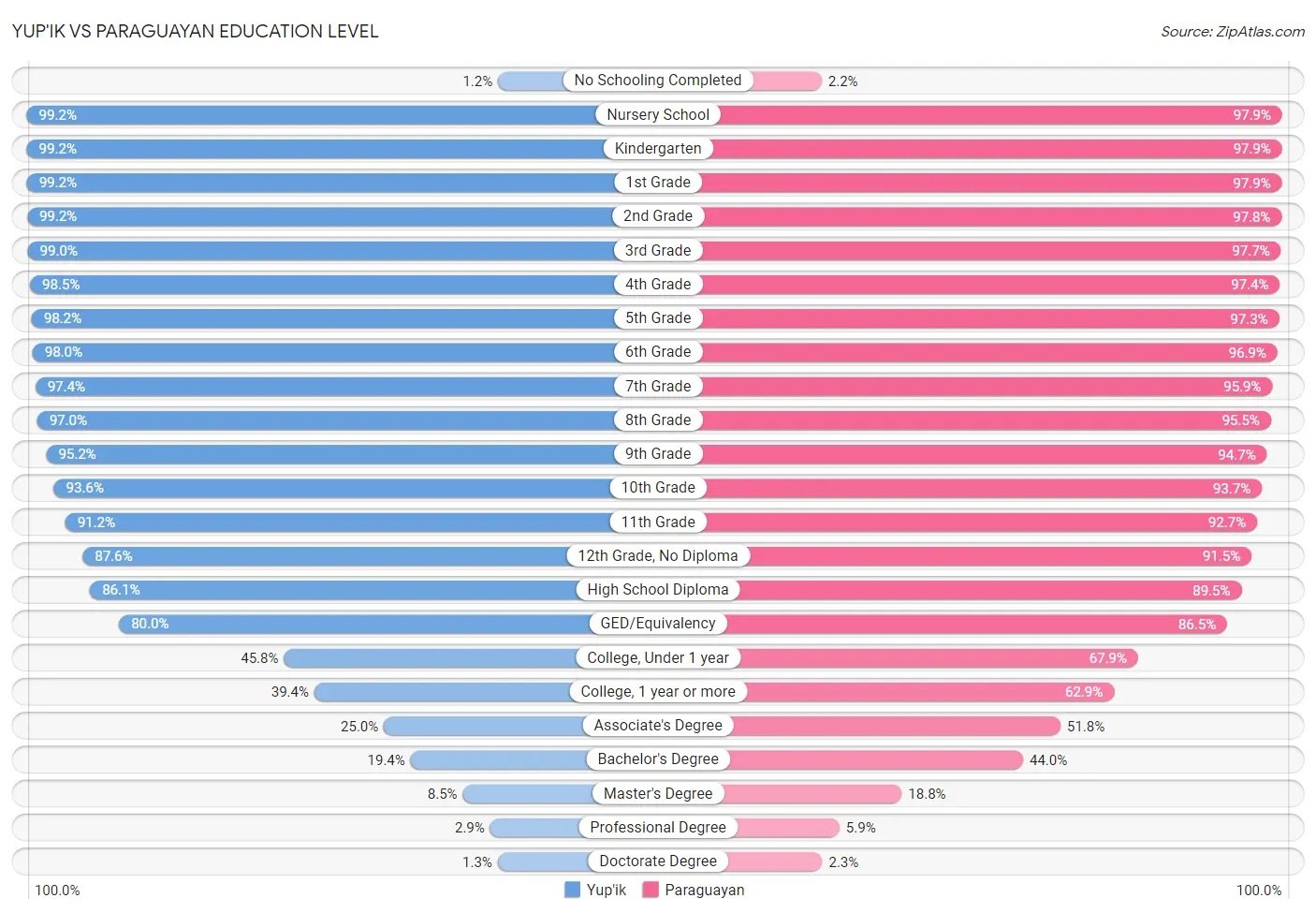
| Education Level Metric | Yup'ik | Paraguayan |
| No Schooling Completed | Exceptional 1.2% | Fair 2.2% |
| Nursery School | Exceptional 99.2% | Fair 97.9% |
| Kindergarten | Exceptional 99.2% | Fair 97.9% |
| 1st Grade | Exceptional 99.2% | Fair 97.9% |
| 2nd Grade | Exceptional 99.2% | Fair 97.8% |
| 3rd Grade | Exceptional 99.0% | Fair 97.7% |
| 4th Grade | Exceptional 98.5% | Fair 97.4% |
| 5th Grade | Exceptional 98.2% | Fair 97.3% |
| 6th Grade | Exceptional 98.0% | Fair 96.9% |
| 7th Grade | Exceptional 97.4% | Fair 95.9% |
| 8th Grade | Exceptional 97.0% | Fair 95.5% |
| 9th Grade | Excellent 95.2% | Fair 94.7% |
| 10th Grade | Fair 93.6% | Average 93.7% |
| 11th Grade | Tragic 91.2% | Good 92.7% |
| 12th Grade, No Diploma | Tragic 87.6% | Good 91.5% |
| High School Diploma | Tragic 86.1% | Good 89.5% |
| GED/Equivalency | Tragic 80.0% | Excellent 86.5% |
| College, Under 1 year | Tragic 45.8% | Exceptional 67.9% |
| College, 1 year or more | Tragic 39.4% | Exceptional 62.9% |
| Associate's Degree | Tragic 25.0% | Exceptional 51.8% |
| Bachelor's Degree | Tragic 19.4% | Exceptional 44.0% |
| Master's Degree | Tragic 8.5% | Exceptional 18.8% |
| Professional Degree | Tragic 2.9% | Exceptional 5.9% |
| Doctorate Degree | Tragic 1.3% | Exceptional 2.3% |
Yup'ik vs Paraguayan Disability
When considering disability, the most significant differences between Yup'ik and Paraguayan communities in the United States are seen in disability age under 5 (4.5% compared to 2.0%, a difference of 129.1%), hearing disability (5.8% compared to 2.7%, a difference of 119.8%), and disability age 65 to 74 (37.8% compared to 20.5%, a difference of 84.3%). Conversely, both communities are more comparable in terms of cognitive disability (16.9% compared to 16.8%, a difference of 0.31%), female disability (11.6% compared to 11.2%, a difference of 3.2%), and disability age 5 to 17 (4.8% compared to 5.1%, a difference of 6.7%).
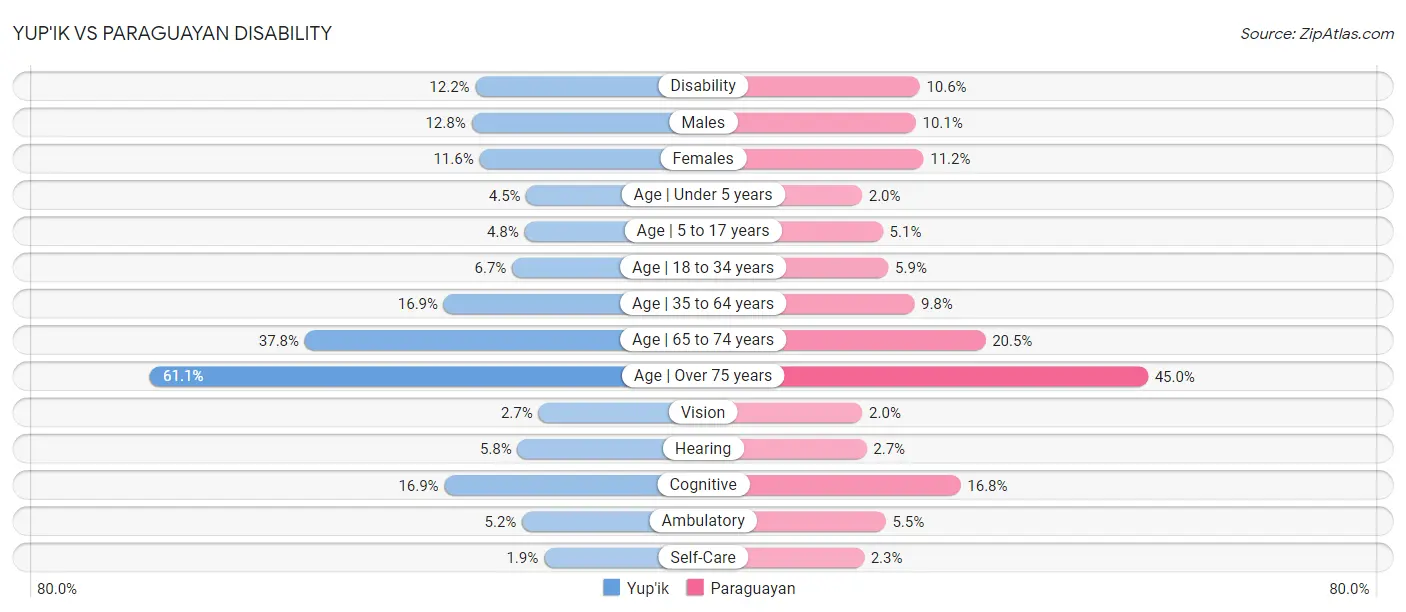
| Disability Metric | Yup'ik | Paraguayan |
| Disability | Tragic 12.2% | Exceptional 10.6% |
| Males | Tragic 12.8% | Exceptional 10.1% |
| Females | Exceptional 11.6% | Exceptional 11.2% |
| Age | Under 5 years | Tragic 4.5% | Tragic 2.0% |
| Age | 5 to 17 years | Exceptional 4.8% | Exceptional 5.1% |
| Age | 18 to 34 years | Fair 6.7% | Exceptional 5.9% |
| Age | 35 to 64 years | Tragic 16.9% | Exceptional 9.8% |
| Age | 65 to 74 years | Tragic 37.8% | Exceptional 20.5% |
| Age | Over 75 years | Tragic 61.1% | Exceptional 45.0% |
| Vision | Tragic 2.7% | Exceptional 2.0% |
| Hearing | Tragic 5.8% | Exceptional 2.7% |
| Cognitive | Exceptional 16.9% | Exceptional 16.8% |
| Ambulatory | Exceptional 5.2% | Exceptional 5.5% |
| Self-Care | Exceptional 1.9% | Exceptional 2.3% |